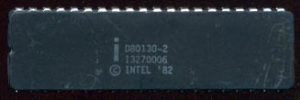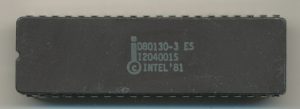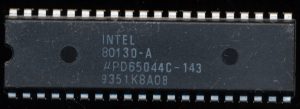When Intel Runs out of Chips…..
A seemingly impossible occurrence today, but something that Intel has faced in the past. It is common for customers to need chips that are no longer in production, either for repair of legacy systems, or to keep an old but reliable design in production. Typically these parts can be sourced on the secondary market, or from End-of-Life suppliers such as REI, or InnovASIC. But what happens when Intel themselves needs a chip that they previously made, but no longer do?
Such was the case with the 80130 Operating System Processor. The 80130 was a co-processor designed in 1981, to make use of Intel’s high-density ROM capabilities. The 80130 contained 16K of ROM, 3 timers (compatible with 8254), an interrupt controller (similar to the 8259), and a baud-rate generator. It was capable of bus management and control and could directly control an 8087 FPU as well. These are designed to work with the 8086/88 and 80186/188 processors. The 16K of ROM was coded with 35 Operating System primitives (a subset actually of the Intel iRMX86 RTOS (Real Time Operating System). This firmware allowed easier support for the constructs typically used in a multitasking OS. Essentially the 80130 extended the instruction set of the x86 to include higher level OS functions.

Intel D80130-2 – 1983 – Production version (though datasheets continued to be marked ‘Preliminary’ though its entire life)
The original version, called (for no known reason) the 80130-3 was released in engineering sample versions only. It could run at up to 8MHz allowing it to work with any of the x86 processors of the time. After some small timing adjustments, the 80130 was released to production as the 80130-2, still keeping with the 8MHz max. Later references show a 80130 at 5MHz as well as the 8MHz -2 part. However, the 5MHz part has not been seen (as of this writing) and is likely to exist only in datasheets.
A similar part was made by Intel called the 80150-2. The 80150 was merely a 80130-2 with different firmware. In this case the entire CP/M-86 Operating System was squeezed into the 16K ROM of the chip. This proved to be even less popular, likely in large part to CP/M being a rather expensive and unpopular OS at the time. To date, I have never actually seen a D80150-2 part.

D80130-6 – Late 1983 – This is the ROMLess version, and what would become the only version available. They cost $50 in 1986
It was found that the iRMX86 firmware included on the 80130-2 was less then popular, as it still required additional ROMs to support the rest of the OS, or another OS using the iRMX86 primitives. Customers, including Compupro, asked Intel for a ROMLess version of the 80130, which would allow use of all 3 timers (2 were previously tied to the Firmware) and the 8 level interrupt controller. These chips became the 80130-6, and by the mid-80’s were the only chips available.
Intel used the 80130-6 on their own Single Board Computers, including the iSBC188/048 and /056. These boards ran the Intel iRMX86 Operating system, but somewhat ironically on external ROMs, since they used the ROMLess 80130-6. While the 80130 turned out to be not a popular chip, the iSBC188 was a popular computer, one that continued to see sales into the 1990’s, and is still in use today.
Intel stopped making the 80130 before 1988 however, leaving them in the position of needing a chip that they designed, but no longer made. It wasn’t worth making runs of them in a fab, as this was capacity they needed for other, profitable chips, and likely the process they used to make it originally was a relic of the past. So Intel did what InnovASIC does today….
They recreated the 80130 in a gate-array, in this case a uPD65040 series from NEC. These wee a CMOS-3, 2-micron gate array from 1986, that had just over 4000 logic cells (each cell contains 4 transistors, or the equivalent of a single NAND or NOR gate). This was sufficient for replicate the functions of the 80130-6, which were really fairly simple due to it no longer using the 16K ROM. Replicating timers, an interrupt controller, bus management, and a baud-rate generator are a fairly simple task. The uPD65040 could operate at up to 50MHz so matching the clock speed was no problem. The difficult part was matching the exact timing and drive-strengths of the original HMOS 80130, it is likely that there were/are some applications that the NEC version does not work in. These NEC 80130-A’s (aka uPD65044C-143 ) continued to be produced into the mid-1990’s and can often been seen on Intel iSBCs.
As an aside, the 80130 wasn’t the only chip on Intel computers that they had to source elsewhere, the original Intel 8220 bus buffers were only made for a short time, leading Intel to later implement them in a gate array from Atmel.



